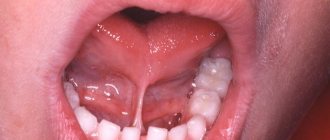Violations in the pronunciation of vibrants—the sounds “r” and “ry”—are very common. They account for up to 26% of all sound pronunciation disorders; the guttural “r”, known as burr, is especially common. Normally, until the age of 5-6 years, children may not pronounce vibrants. But if, upon reaching this age, the child has not mastered them, parents should contact a speech therapist. If they noticed the violation even earlier, there is no need to wait 5 years - go earlier.
In the article we will talk about the reasons for incorrect pronunciation of vibrants, speech therapy, games and exercises that you can do with your preschooler at home.
Reasons for incorrect pronunciation
A child may not be able to pronounce vibrant for various reasons. Let's list them:
- Anomalies of the frenulum - it may be shortened and incorrectly positioned. In some children, the hyoid ligament can be stretched with exercises. But sometimes the bridle has to be cut;
- Features of the structure of the tongue - its narrowing or enlargement (macroglossia);
- Anatomy of the jaws - a narrow upper jaw, an incorrect bite can also interfere with the pronunciation of the vibrant;
- Anomalies of the palate - with a cleft or gothic palate, vibrants are difficult to achieve;
- Incorrect location or absence of teeth in the upper jaw;
- Hearing abnormalities - in this case, the baby may not perceive vibrant by ear, an even more difficult situation is physical hearing impairment;
- Hypotonia - weak muscles are characteristic of dysarthria;
- Imitation. It often happens that a child pronounces vibrant, but comes to a children's group, where the children “burr.” And he begins to repeat after them - the skill is lost.
Its correction also depends on the cause of the speech disorder. This requires consultation with a neurologist and speech therapist. The specialist will write out a program for stage-by-stage sound production. The earlier the correction is started, the easier it is to achieve good results.
Stage 1: preparation for correctional work
It consists of identifying the sound “p” and its substitute by ear and comparing their articulation. To develop the articulatory skills that are needed to make the sound “r”, the speech therapist prescribes special exercises for the little patient - for the lips, tongue and lower jaw.
At the stage of preparation for sound production, it is necessary to introduce the baby to the parts of his language. The easiest way to show them is on the palm of your hand: tip, back, edges, tummy. This will make it easier for your baby to do the exercises.
Stage 2: setting the sound “r”
There are several approaches: staging by imitation, from other sounds, mechanically and with the help of gymnastics. Next we will look at these staging methods in more detail.
Stage 3: vibrant automation
To do this, the child pronounces syllables and words, and then more complex tongue twisters, tongue twisters, rhymes and phrases - with different stress and vowel. This allows you to bring pronunciation to automaticity.
Stage 4: introducing vibrant into speech
The final sound “r” is formed in children within 25–40 days, sometimes it takes up to 60 days. Although there are often cases when the correction continues throughout the year. You need to work with a speech therapist at least twice a week, and continue the rest of the days at home on the recommendation of a specialist.
Why is clear speech so important?
In the early stages of growing up, a child needs a team, and due to a slight defect, the baby may feel like a stranger among his peers. Everything heats up in adolescence: many guys find burr funny, so they never miss the opportunity to somehow offend the poor guy. Finding himself in such a situation, a teenager forms new complexes that he may never get rid of.
Burr will affect an adult no less seriously. Yes, usually at this stage people stop openly throwing insults, but ridicule behind your back does not go away. A slight defect can seriously hamper career advancement. Some doors will remain closed altogether, since many professions are speech-demanding.
There is a misconception that problems with the letter “r” are solved exclusively in childhood. This is not entirely true. Defects can be “treated” at any time: even an elderly person can stop burring if they make an effort.
Drawing up a correction program
It depends on the form of the sound pronunciation disorder. For example, a child may have no vibrant in his speech at all, or he may replace it with other sounds or mix them. Rotacisms, that is, distortions, are also common. There are 8 types of rotacisms. Therefore, the speech therapist selects a step-by-step production of the sound “r” individually for each little patient. However, there is a list of exercises that are suitable for any form of vibrant pronunciation disorder.
“Imitation” technique for simple cases
The staging exercise involves auditory perception of sound. The little student is offered examples of phonemes, for example, the roar of a motor, thunder. And he, sitting in front of the mirror, repeats what he heard.
Gymnastics for lips
The complex includes 3 exercises:
- "Let's smile!" The baby smiles, showing all his teeth. The duration of the approach is 5 seconds.
- "Tube". There are 2 variations of this exercise. The student stretches out his lips, imitating a tube, silently “reproduces” the sound “u” or closes his teeth and slightly stretches his lips forward so that a square is formed.
- "The doors are opening." The baby slowly opens his mouth so that there is a distance of 10 mm between the teeth of both jaws.
Then he smiles, showing his teeth.
Gymnastics for the tongue
To pronounce sounds correctly, you need to control your tongue muscles well. Here are the staging exercises offered to children.
"Pancakes"
The baby relaxes his tongue and places it on his lower lip. In this case, the teeth should not be covered with lips. If this variation of the exercise proves problematic, have him stick his tongue out between his lips and say “ba-ba-ba.” After this, spread the tongue again and blow until a groove is formed in the middle.
“Whose teeth are cleaner?”
The baby opens his mouth slightly and begins to “clean” the inside of his upper teeth with the tip of his tongue. Movement of the tongue - left and right.
"Cat"
The tip of the tongue bends upward. If this is problematic, suggest licking the upper teeth from the outside from left to right, and then the upper lip in the same way.
"Painter"
The baby smiles, opens his mouth and runs his tongue across the hard palate. The direction of movement is towards the teeth and away from them.
"Swing"
The exercise is performed inside the mouth. The tip of the tongue is bent alternately up and down between the teeth. At the same time, it must be gradually pulled deeper into the oral cavity.
"Horse"
The baby flicks the tip of his tongue, then sucks it to the front edge of the palate and tears it off. At the same time, he opens his mouth wide.
"Fungus"
Starting position – exercise “Smile”. The baby sucks the front part of the tongue to the hard palate, closes and opens his lips. The ligaments under the tongue become tense and mild pain should occur.
"Machine gun"
The student smiles, opens his mouth and taps the tip of his tongue on the inner surface of his upper teeth. At the same time, he clearly says “d-d-d-d.”
"Plane Sound"
Starting position - “Smile”, the tip of the tongue is located behind the upper teeth. The baby says “z” and “z” until the sound is similar to the roar of a motor.
How to stop burr
In early childhood, incorrect pronunciation of various sounds is natural and physiologically justified. It is determined by the development and formation of the child’s body. Very often, children skip or change sounds, rearrange syllables, omit the beginning of a word, or place the wrong emphasis. But with age, these mistakes gradually disappear on their own or with the usual help of parents, and speech becomes sonorous and meaningful. If a child over three years old continues to speak unclearly, burrs, or pronounces some sounds incorrectly, you need to pay close attention to this and meet with a speech therapist. Speech deficiencies in a child, including burr, cause many problems in the future - isolation, timidity, fear of attention to oneself, embarrassment when reading poetry or participating in children's performances in kindergarten. Uncertainty in your pronunciation can cause very quiet speech, which subsequently interferes with both study and work.
Obviously, unclear speech and abnormal sounds require professional intervention. It is necessary to check the child’s hearing, his perception of sounds and intonations. Also consult a speech therapist, who will identify the specific cause of burr and its type, for which he will test the features of the articulatory apparatus in terms of lifestyle, health and age. Then the method of setting “P” and a suitable set of exercises and activities will be selected to get rid of burr.
If the main cause of the problem lies in a short frenulum, they try to stretch it with special gymnastics for the tongue, for example, you need to reach the middle of the chin with the tongue or, tilting your head back slightly, stretch the tongue towards the nose. In cases where the frenulum cannot be stretched, it is trimmed. This operation is performed by a dentist under local anesthesia, most often on an outpatient basis.
Ways to get rid of burr
- Articulation gymnastics.
- Massage of the entire tongue and mechanical (forced) vibration of the front part.
- Tactile control.
- Long and systematic lessons during the period of automation of the sound “R”.
At the initial stage of correcting burr, it is necessary to achieve the correct pronunciation of an independent, isolated “R”. To do this, the pronunciation of one’s own “R” and its substitute is determined and compared by ear, then these sounds are compared and, based on the results of the analysis, articulatory skills are formed to produce the sound of “R”. Each type of defect has its own tasks and exercises.
Sound production depending on the source data is carried out:
- From reference sounds.
- By imitation.
- With mechanical assistance.
- Articulation exercises.
Exercises for correct pronunciation of the sound “R”
To develop the upward movement of the tongue and the ability to move it well when burring, do the exercise “Whose teeth are cleaner?” The lips should be open, as for a wide smile, with the upper and lower teeth visible. The lower jaw does not move. The tip of the tongue, without bending, is located at the roots of the upper teeth. They need to move along the inner surface of the teeth from right to left and back, as if to “clean” the teeth.
To improve tongue mobility when burring, perform the “Painter” exercise. You have to open your mouth and smile. Fix the lower jaw and lips in a motionless state, then, making back and forth movements with the tip of the tongue, stroke the sky with it. It is necessary to ensure that the tip does not protrude from the mouth, but must reach the inner surface of the upper teeth.
To obtain a long, powerful and continuous air stream with burr that goes in the middle of the tongue, they suggest the exercise “Who will kick the ball further.” You need to smile, making sure that the lower lip does not stretch over the lower teeth. Place the wide front edge of the tongue on the lower lip and, pretending to pronounce “F” (but in no case “X”, this must be strictly monitored), as if blowing a cotton ball (cotton ball) as far away from you as possible .
To develop a tongue position resembling a “cup” and to develop upward movements of the wide front part during burr, do the “Tasty Jam” exercise. You need to open your mouth slightly and, moving from top to bottom, lick your upper lip with the front edge of your tongue, but do not move from side to side. In this case, you need to control that the lower jaw does not move; you can help keep it still with your hands. The tongue should be spread wide and touch the lateral edges of the corners of the mouth.
These are not all the simplest exercises that are indicated for all types of burr. After mastering them or simultaneously with them, special exercises are performed to solve specific problems. The result should be a correctly pronounced isolated “Rrrrrrrrr”….
☞ Video exercises
Sound Automation
To stop burring, it is not enough just to learn to pronounce “R”, it must be inserted into words. This may not happen right away.
- With burr, you first need to master simple open syllables, consonant sound + vowel sound, namely “RA”, “RO”, “RU”. They are pronounced in a row and separately, alternating with each other. Getting used to these syllables can be turned into a game with your child. Then you need to pronounce the words when the memorized syllables are first at the beginning of the word - FRAME, and then at the end - FEATHER, MOUNTAIN, etc.
- The next stage is to pronounce closed syllables first independently “AR”, “OR”, “UR”, etc., and then in the words SUGAR, WIND, TOMATO.
- Following this, they begin to construct phrases and memorize tongue twisters. In a similar way, they learn to pronounce the soft “Ry”.
Three ways to stage
Is your baby able to do articulation exercises? You can proceed to the next stage - sound production. The speech therapist has mechanical techniques in his arsenal.
- Spatula and nipple technique. The doctor places the pacifier on a wooden spatula. The student assumes the “Airplane drone” position. The specialist makes rapid movements under the tip of the tongue until it begins to vibrate. Movements - up and down, left and right. This technique is more effective if the baby's head is on the doctor's lap.
- Vibration - using paper. A wad of paper is placed on the tip of the tongue, a string is tied to it so that the paper does not fall on the floor, and it is given to the baby. He hides his tongue behind his upper teeth and tries to blow the paper off his tongue.
- Repetitions of the sound "d". The student sits in front of a mirror, opens his mouth slightly, places the tip of his tongue at the beginning of the upper teeth and quickly repeats “d-d-d-d.” Then he connects “d” with vowels: “d-d-a”, “a-d-d” and then the rest of the letters.
At this time, the specialist places a spatula under the front edge of the tongue and carries out frequent oscillatory movements. This contributes to the pronunciation of the rumble that is characteristic of vibrant.
Home correctional exercises
Where to start staging sound at home? First you need to prepare your lips and tongue using articulatory gymnastics, which you read about above. Once you have prepared the base, start staging. There are several effective ways to stage it.
From the sound "d"
Ask your son or daughter to say “d-d-d” loudly. The tip of the tongue rests heavily on the alveoli (tubercles on the roof of the mouth). You need to speak protractedly and without stopping. The tongue is pressed tightly against the tubercles. At some point, the tongue will begin to vibrate, and the baby will say “ddd-rrr.” A start!
Then you can complicate the task: add syllables in which the vibrant sounds hard: “dra”, “dru”, “dro”.
When the baby masters the skill, it’s time to introduce vibrant into speech. Move on to pronunciation of words: “dragon”, “fight”, “friendship”, etc.
Then replace the syllable “dr” with “tr”. Let the baby say the words “coward”, “throne”, etc.
The final stage is to turn off the sound “d”. Choose other words and phrases, for example: “thunder - grenade”, “ford - beard” and others.
Method of setting from the sound “zh”
If the baby pronounces “w” correctly, you can build on it. Ask your daughter or son to forcefully say “w” and at the same time move the tongue as far into the oral cavity as possible. You should get a single-stroke “r”. You need to repeat this exercise until it is fixed, and then, by analogy with the first technique, we bring it to automatism and introduce it into speech: we start from the syllable “zhr”, then “dr”, “tr” and further.
Method of setting from the sound “s”
If the baby pronounces “s” correctly, you can build on it. It is usually pronounced while exhaling, but when placing the “r” it must be pronounced while inhaling.
Ask your baby to say “sssssss,” then inhale a little through his mouth and press his tongue against the bumps on the roof of his mouth. It should look like a short "r".
The further scheme is the same as with other techniques.
Introduction of vibrant into speech
In simple cases, you can not only teach your baby to pronounce “r” on your own, but also introduce it into speech. To do this, first bring the isolated sound pronunciation to perfection. And then introduce it into speech using the following exercises:
- first the baby pronounces it in syllables;
- then pronounces it in words, with different syllables: “r” should be at the beginning, and in the middle, and at the end;
- connect stories, proverbs, phrases - this is the final stage.
Do all the exercises in the form of a game - this is how little children learn any material well. You will need imagination to captivate your son or daughter. Classes should be a joy for the little one, otherwise he will be tense and even the most effective exercise will not help achieve the desired result.
Why don't classes help?
For what reasons may difficulties arise in staging sound at home?
Firstly, the baby is not 4 years old. Before this age, it is pointless to even try to put “r”, since it simply does not exist and cannot exist - this is the pattern of speech development in children. It appears the very last. Parents, don't rush things!
Secondly, incorrect articulatory posture. Should be normal
the lips are stretched, the tongue is raised up, its tip is trembling, there is a strong directed air stream, the vocal cords are vibrating. Perhaps the baby is simply adopting an incorrect articulatory posture. If there is insufficient movement, the “r” will not give in to it.
Thirdly, improper breathing. To be able to pronounce “r”, you need a strong directed air stream that makes the tip of the tongue vibrate. If the baby does not distinguish between mouth and nasal breathing, you need to first work on this point.
Fourthly, unformed phonemic hearing. The baby may simply not yet perceive “r” by ear and, accordingly, cannot distinguish it either.
Fifthly, organic reasons. We are talking about the structural features of the facial apparatus - a short frenulum, a large or small tongue, for example. This also includes neurological disorders.
If you exercise with your baby at home, but the exercises do not produce results, consult a doctor. He will identify the cause and offer effective treatment methods for your child.
conclusions
If you notice that your preschooler has problems pronouncing “r,” contact a speech therapist. The specialist will conduct speech therapy tests, evaluate your child’s articulatory apparatus and identify the cause of the disorder in sound pronunciation. This will allow us to develop a correction program that will be effective specifically for your child.
You need to exercise regularly. As a rule, classes take place 2–3 times a week. But parents should also be involved in the process. You need to continue doing the exercises at home - then the result will not take long to arrive.
If a consultation with a neurologist or surgical intervention (for example, cutting the frenulum) is necessary, this will allow you not to waste time and quickly solve the problem.
Typically, parents of children aged 5 to 6 years turn to a speech therapist. But if you notice a problem earlier, don’t wait - go to a specialist. But you shouldn’t go earlier than 4.5 years either.
Burr - what is it?
The ability to clearly formulate and express thoughts and feelings out loud, and not just on paper, the ability to talk about one’s thoughts, summarize their results and draw conclusions is not given to a person at birth; this can and should be learned. It is very important for teachers, lawyers, psychologists, and researchers to speak beautifully and coherently. The ability to persuade with the spoken word is necessary for doctors, artists, lawyers and all managers.
Burr is a “folk” term that usually denotes difficulty in pronouncing the sounds “R” and “R”. In medicine there is another name - rotacism. There are several types of rhotacism, but two types are most often discussed:
- Velar, when the throaty pronunciation of the sound “R” is heard. In this case, vibration is carried out by the velum palatine near the root of the tongue.
- Uvular, when “R” is pronounced roughly with anguish, a growling sound appears. Vibration in this case is carried out by a small tongue.
In addition, there is grazing - a soft pronunciation as if in French without the participation of the tongue due to throat vibration.
The position of the vocal apparatus with the correct pronunciation of the sound “R”
The articulation when pronouncing “R” resembles the articulation of hissing sounds. It is distinguished by high tension on the tip of the tongue and its vibration in a precisely directed powerful air stream.
When pronouncing the sound “R”, the lips are either half-opened or in the position for pronouncing the sound that follows the “R” in the word. The teeth are open. The front edge of the tongue should take the shape of a spoon, be raised to the base (roots) of the upper teeth and vibrate under the pressure of exhalation. The lateral edges of the tongue at this moment are pressed against the upper molars, and its back part (the root of the tongue) is lowered and pushed back to the soft palate, which is raised and covers the nasal passage. The vocal cords are closed and actively vibrate, which can be felt by placing your palm on the larynx.
The articulation when pronouncing the soft “Рь”, which is more often found in the Russian language, differs from the articulation of the hard “R” by some rise to the palate and movement forward of the middle part of the back of the tongue.
Variants of violations with burr
- Complete absence of the “R” sound.
- The throat “P” occurs due to improper vibration of the tip of the tongue.
- "R" sounds like "RL". This is a lateral pronunciation.
- “R” is pronounced through the nose, nasally, “NG” is heard, due to speech exhalation through the nose, at a time when the root of the tongue is tightly pressed to the soft palate.
- A one-beat “R” without a rolling sound, when there is only one blow with the tip of the tongue on the alveoli - one-beat rotacism.
- One- and two-sided buccal “P” with an admixture of extraneous noise due to vibration of the cheek - lateral rotacism. This occurs when a gap forms between the upper teeth and the side edges of the tongue, through which a stream of air escapes when exhaling.
- Replacing “R” with other sounds in spoken words (pararotocism) - “D”, “L”, “G”, “Y”, “Y” or a softened pronunciation of a combination of sounds, for example, instead of “RO” - “RE” or instead "RA" - "RYA".
The main causes of burr
Doctors do not consider burr to be a disease in the literal sense of the word; however, determining the causes of burr and how to eliminate it is the prerogative of doctors, including speech therapists. Eliminating burr, which can interfere with communication, cause various complexes, and become an obstacle in the future when choosing a specialty (it is unlikely that you can become a burr on radio or television) is best done in preschool childhood. A child’s speech apparatus is usually fully formed by the age of seven. But, even as an adult, you need to figure out how to stop burring in order to overcome this defect (I don’t want to call it a defect).
The causes of burring are both medical and psychological:
- Hereditary factor.
- Insufficiently developed speech breathing in children; it is difficult for the child to take a deep breath while pronouncing words.
- A shortened sublingual frenulum that limits movement of the tip of the uvula and the anterior portion of the dorsum of the tongue. This restriction distorts spoken sounds and leads to burr.
- Weakness of the tongue muscles or even their partial paresis, which is accompanied by the inability to perform certain movements.
- Decreased normal hearing. Lack of auditory perception since childhood. Problems with phonemic hearing.
- A child copying the speech of an adult who burrs.
- Raising and educating a child in a bilingual family, when a violation of the structure of the uvula may occur. Confusion in the baby's head about the ways of pronouncing different sounds in different languages provokes burr.











